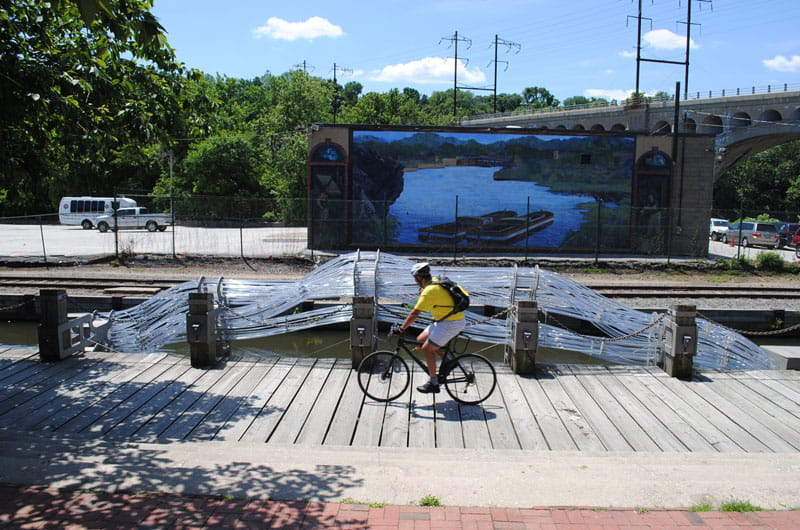Public Forum on Creative Placemaking and Reimagining Bartram’s Mile

Bartram’s Mile, a one-mile stretch of riverfront along the western banks of the Schuylkill River in Philadelphia, has been vacant and cut off from public access for decades. But a plan to reimagine this section of the Schuylkill Banks is currently underway, led by Philadelphia Parks & Recreation.
The plan will create new green space for Southwest Philadelphia, present new visitation opportunities for the nearby Bartram’s Garden and help set the stage for larger public access projects along this stretch of the trail, including the restoration of the abandoned rail swing bridge south of Grays Ferry Avenue. The project will break ground this fall, with an expected completion date of spring 2016.
“While redeveloping Bartram’s Mile represents a significant step in advancing public access to Bartram’s Garden, numerous opportunities still exist to use other tools to attract visitors to a trail and park space that is relatively isolated,” said Harris Steinberg.
Steinberg is executive director of Drexel’s Lindy Institute for Urban Innovation and a distinguished teaching professor of architecture and interiors in the Antoinette Westphal College of Media Arts & Design, who is one of the leading practitioners and teachers of urban planning and civic visioning in the region.
To help attract visitors to the area, Steinberg joined forces with Mural Arts to create an action plan for public artwork and creative placemaking along Bartram’s Mile to engage the local community and bring citywide and regional attention to the mile as a new addition to the regional trail system in Philadelphia. The project takes some bold first steps to draw people to Bartram’s Mile, animate the trail and bolster Bartram’s Garden’s role as an environmental education center along the river.
In addition to Mural Arts and the Lindy Institute, the project is being conducted in conjunction with Bartram’s Garden, Philadelphia Parks & Recreation, the Schuylkill River Development Corporation, the Office of the Arts, Culture and Creative Economy and the Philadelphia Industrial Development Corporation, with support from the William Penn Foundation.
Much of the group’s work over the past few months will culminate in a two-day design charrette on May 14 -15. On the first day, local and national experts in art, civic stewardship and green infrastructure will gather together at Bartram’s Garden to tour the site and think deeply about potential opportunities. The following day, a workshop will be held to compile the recommendations into an action plan.
On Thursday, May 14 from 6:30 – 8 p.m., a public lecture and forum, “Making Place by Building Civic Stewardship & Public Art-Making,” will take place in Drexel’s Leonard Pearlstein Gallery (3401 Filbert St.). This event is free and open to the public. A reception will be held prior to the event at 6 p.m. Attendees are encouraged to RSVP here.
Three panelists will give presentations about their work as it relates to creative placemaking, civic stewardship, social equity, public art and environmental infrastructure. Panelists include Majora Carter, an urban revitalization strategist for Majora Carter Group, LLC; Jennifer McGregor, director of arts and senior curator for Wave Hill New York Public Garden and Culture Center; and Gonzalo Casals, vice president of programs and community engagement for Friends of the High Line. Following the presentations, the panelists will engage in a question-and-answer session with the audience.
“This forum is an important opportunity for public conversation about larger issues that are part of a national trend that tries to merge public art with economic development and environmental stewardship,” said Steinberg. “This is also an opportunity to garner the perspectives of national experts and thought-leaders and apply them to the Bartram’s Mile project and more broadly across Philadelphia.”
Carter is an urban revitalization strategy consultant, real estate developer and Peabody Award-winning broadcaster. She is responsible for the creation and successful implementation of numerous green-infrastructure projects, policies, and job training & placement systems. After establishing Sustainable South Bronx and Green For All (among other organizations) to carry on that work, she built on this foundation with innovative ventures and insights into urban economic developments designed to help move Americans out of poverty.
Casals currently works at Friends of The High Line, the nonprofit organization that operates and programs one of Manhattan’s most innovative public spaces. As director of public programs, education and community engagement, he is responsible for cultural strategies that foster belonging, build equity and resources the neighborhood. Prior to The High Line, Casals worked at El Museo del Barrio, and co-founded and directed Queens Media Arts Development (QMAD), a Queens-based organization that produces and implements programs in the media arts to encourage Queen’s multicultural communities to actively participate in the forging of an artistic identity for the borough.
McGregor is the director of arts and senior curator at Wave Hill, a 28-acre public garden and cultural center in the Bronx, presenting artworks in the galleries and on the grounds that engage the public in a dialogue with nature, culture and site. She has curated exhibitions such as Out of Bounds, wall drawings relating to landscape, and projects such as Katie Holten’s Tree Museum. Previously, as director of the New York City Percent for Art Program, she implemented the program guidelines and supervised the first sixty public art projects. In 1990, she founded McGregor Consulting to work nationally on public art commissions, master plans, exhibitions and planning projects.
Drexel News is produced by
University Marketing and Communications.
